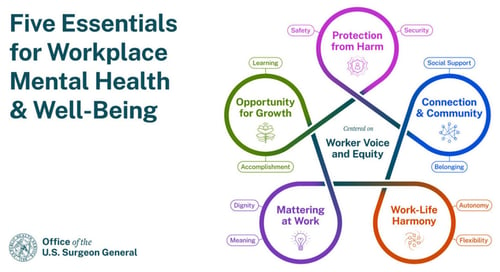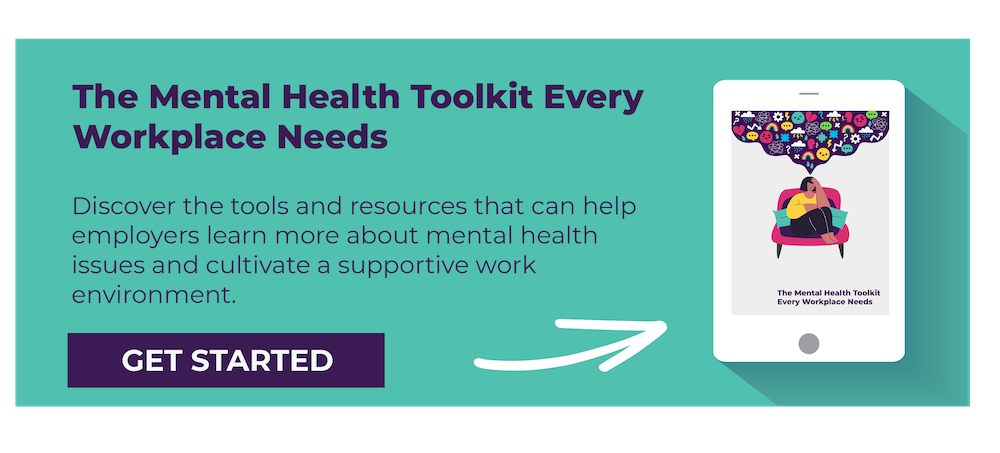Workplace mental health is a hot topic these days.
As the world moves past the pandemic and its unique experiences — in-house work to remote work only and back again, for example — it added extra mental strains on everyone, but especially employees.
In October, the U.S. Surgeon General launched the national workplace mental health guide in Philly. The framework released includes a 30-page guide to help employers and their workers build a work environment based on five main areas: protection from harm, connection, and community, work-life harmony, mattering at work, and opportunity for growth.
This post will cover the guide’s details. Plus, you’ll learn tips for how to implement and sustainably grow company mental health programs now and in the future.
Workplace Mental Health: Where It Stands Today
A good job that pays well and brings joy to workers is what more of the workforce needs these days. For many, long days at work should be mostly enjoyable and not miserable.
The pandemic made it glaringly obvious that workers weren’t happy. Thankfully, employers are taking note given the data that’s being released around workplace satisfaction and mental health.
Nearly 59% of employees felt they experienced negative impacts of work stress, according to a 2021 American Psychological Survey. Study after study and much research has revealed that unhappiness will take its toll with more labor shortages and beyond.
Luckily, workers are finally feeling heard in the workplace in 2022.
The American Psychological Association reported seven in 10 workers believe employers are more concerned about employees’ mental health than in the past.
It’s true employees manage daily stress that has an impact on their organizational performance and their health. Whether it's multiple jobs, unpredictable schedules, limited autonomy, long commutes, or something else, workers want to know their work can be enjoyable and healthy.
With effort from both worker and employer, engagement, better health, and improved work experiences are on the horizon.
The Workplace Mental Health & Well-Being Framework
Need some inspiration for where to begin when it comes to mental health in the workplace?
Below, we take a look at the highlights from The U.S. Surgeon General’s Framework for Workplace Mental Health & Well-Being, a 30-page report.
The areas below are considered “essential” to workplace mental health and well-being. Employers can refer to these often to inspire ideas for wellness campaigns and for improving mental health in the workplace.
Here are the five areas to consider:
1. Protection from Harm
This equates to safety and security in the workplace. Workplace safety ensures a safe and healthful work environment for employees where they’re protected from physical harm, injury, illness, and death.
Workers should be protected in these ways:
- Allowed adequate rest
- Normalized and supported mental health
- Prioritized workplace physical and psychological safety
- Operationalized DEIA (Diversity, Equity, Inclusion & Accessibility) norms, policies, and programs
Food for Thought: How are you making your workers feel safe and welcome in the workplace?
2. Connection & Community
How can your workers be themselves while still contributing their talents in a productive way at work? Social connection desires extend to the workplace, as supportive relationships are not limited to only close family or friends.
Components of connection and community include:
- Cultures of inclusion and belonging
- Cultivate trusted relationships
- Foster collaboration and teamwork
Food for Thought: How can you start connecting with your team in a way that builds trust each week? In what ways can leadership provide collaboration opportunities?
3. Work-Life Harmony
Balance is key in work and life. How do you meld the work-life experience together for your employees? Research indicates that organizations that allow workers to have more autonomy keep staff longer and see more success.
Here are key components to achieve that balance:
- Increase paid leave access
- Provide more autonomy over how work is done
- Make schedules as flexible and predictable as possible
- Respect boundaries between work and non-work time
Food for Thought: In what ways does your workplace honor work-life harmony? What areas need improvement?
4. Mattering at Work
Do you care about your workers? If so, do they feel that they matter and have worth? Offering the basics like providing a living wage is a start. Creating a workplace that isn’t just about numbers and bottom lines is important to retaining and keeping workers happy.
A few other components to consider:
- Engage workers in workplace decisions
- Build a culture of gratitude and recognition
- Connect individual work with organizational mission
Food for Thought: In what ways can you better engage your workers in workplace decisions?
Related: Your Guide to Cultivating Gratitude in the Workplace
5. Opportunity for Growth
Are you encouraging your workers to grow? Learning professionally and personally is what keeps people from getting stagnant, bored, and frustrated. Accomplishments mean a lot to employees as they can build confidence, and self-esteem, and reduce stress.
Consider these opportunities for growth:
- Ensure relevant, reciprocal feedback
- Offer quality training, education, and mentoring
- Foster clear, equitable pathways for career advancement
Food for Thought: Are you doing training weekly, monthly or quarterly? Can you incorporate a mentorship program or special training?
Related: 5 Free Health and Wellness Classes For Wellness Champions to Try
Tips to Sustainably Grow Workplace Mental Health Programs
Workplaces that have high levels of mental wellness are more productive — as much as 12 percent more — and lead to happier employees. Making a commitment to protect and improve mental health for everyone creates an environment where workers feel safe and cared for by your company’s leadership.
Here are tips for growing and maintaining your mental health initiatives:
- Offer suitable insurance - Most companies can find discounted rates for insuring in bulk. Shop new policies, and talk to reps. Find the best deal while also offering services your team needs to stay healthy, like mental health counseling.
- Ask for feedback - The only way to know how employees are feeling about their workloads, work-life balance, and more is to ask, “Do you have any feedback for me about X?” Let them know you’re specifically interested in their thoughts and ask about what’s working and what isn’t. Then, dive deeper in. It will make your employees feel heard and cared about when they see feedback changes implemented.
- Provide hybrid work environments - Studies are still emerging on the psychological impact of remote and hybrid work. But one thing is clear: Even the option to work remotely part-time reduces stress and anxiety.
- Offer free health screenings - It’s hard to deal with the unknowns of health issues. Perhaps your workers don’t really understand what anxiety or burnout looks like. Offering screening tools can help them give a name to whatever emotional things they may be dealing with. In turn, they can get the proper guidance from a professional once they have a direction. Mental Health America offers free tests like PTSD testing, depression testing, and more.
- Encourage staff to report inexcusable behavior - Make sure your staff knows they can safely report discrimination or harassment they experience or witness. Let them know they can blow the whistle.
- Send managers to training - Provide your leadership with opportunities to attend seminars, workshops, and other events to learn how to better support staff with mental health issues.
Related: 5 Telltale Signs You Need to Take a Mental Health Day From Work
Invest Now in Your Employees’ Mental Health
As we head into another new year, consider a personalized mental health and well-being framework for your company.
How can you take the above examples and apply them to your own workplace mental health programs? It’s time to build a workplace that’s an even better engine of well-being for your hard-working workers.
Need some more inspiration? Check out these resources:
- Job Quality Case Studies (U.S. Department of Commerce)
- Cool and Collected: Keep Your Team Calm in Chaos (TotalWellness)
- Center for Workplace Mental Health (American Psychiatric Foundation)
- Your Guide to Stress Management in the Workplace (TotalWellness)
Workers want to keep working for you. Don’t let a lack of planning of valuable options like mental health resources send them packing. Whether you need to incorporate ideas like flexible work hours, four-day work weeks, respecting time off, or another angle, consider it. Ask your workers what they want. They’ll tell you if given the chance.
How will you offer effective mental health support in the new year? What’s your workplace mental health strategy? Share ideas, tips, and thoughts in the comments below!


